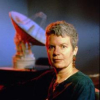Jill Tarter

Jill Tarter
Jill Cornell Tarteris an American astronomer and the former director of the Center for SETI Research, holding the Bernard M. Oliver Chair for SETI at the SETI Institute...
NationalityAmerican
ProfessionScientist
Date of Birth16 January 1944
CountryUnited States of America
earliest leak maybe per sphere year
Our television transmitters leak out from the Earth. And actually, there's a sphere surrounding the Earth from the earliest television signals, maybe 70 years ago, that's going out one light year per year. But it's really weak.
acid battery beneath boiling cooling cracks dry evolved extreme hot human inside life limited miles nuclear permanent pure rocks salt thrive valleys waters
Life has evolved to thrive in environments that are extreme only by our limited human standards: in the boiling battery acid of Yellowstone hot springs, in the cracks of permanent ice sheets, in the cooling waters of nuclear reactors, miles beneath the Earth's crust, in pure salt crystals, and inside the rocks of the dry valleys of Antarctica.
adds build delays eight equipment field individual large phase picking separate signal takes telescope time
I can actually build my equipment at the back end of the telescope such that it takes the data from all of the separate antennas and adds the signal together with different time delays and different phase shifts - it's as if I were picking out up to eight individual pixels in this large field of view.
ancient computer creek donated graduate join knew mainly program project school
As I was leaving graduate school in 1974, I was recruited to join a fledgling SETI project at the Hat Creek Observatory in California, mainly because I knew how to program an ancient PDP8/S computer that had been donated to the project.
basis caught life misuse scientific talk understand
We misuse language and talk about the 'ascent' of man. We understand the scientific basis for the interrelatedness of life, but our ego hasn't caught up yet.
chemistry common laws learning physics planets played turns
We are the laws of chemistry and physics as they have played out here on Earth, and we are now learning that planets are as common as stars. Most stars, as it turns out now, will have planets.
motivation inspiration long
We, all of us, are what happens when a primordial mixture of hydrogen and helium evolves for so long that it begins to ask where it came from.
ocean thinking years
The space that we're looking through is nine-dimensional. If you build a mathematical model, the amount of searching that we've done in 50 years is equivalent to scooping one 8-ounce glass out of the Earth's ocean, looking and seeing if you caught a fish. No, no fish in that glass? Well, I don't think you're going to conclude that there are no fish in the ocean. You just haven't searched very well yet. That's where we are.
mirrors differences perspective
SETI is a mirror, a mirror that can show ourselves from an extraordinary perspective and can help to trivialize the differences among us.
heart home discovery
Might it be the discovery of a distant civilization and our common cosmic origins that finally drives home the message of the bond among all humans. Whether we're born in San Francisco or Sudan or close to the heart of the Milky Way Galaxy, we are the products of a billion-year lineage of wandering stardust. We, all of us, are what happens when a primordial mixture of hydrogen and helium evolves for so long that it begins to ask where it came from.
tribes
Ultimately, we actually all belong to only one tribe, to Earthlings.
distance technology use
We don't know how to identify intelligence over interstellar distances, so what we do instead is use technology for a proxy,
dark ideas light
The story of humans is the story of ideas that shine light into dark corners.
technology our-world long
In the future, will our technologies help stabilise or planet and population, leading to a very long lifetime for us? Or will we destroy our world and its inhabitants, after only a brief appearance on the cosmic stage?